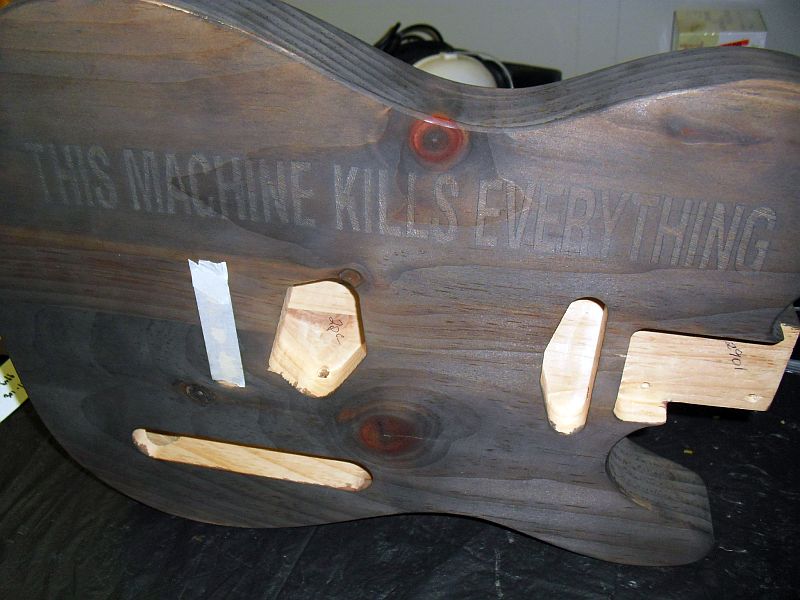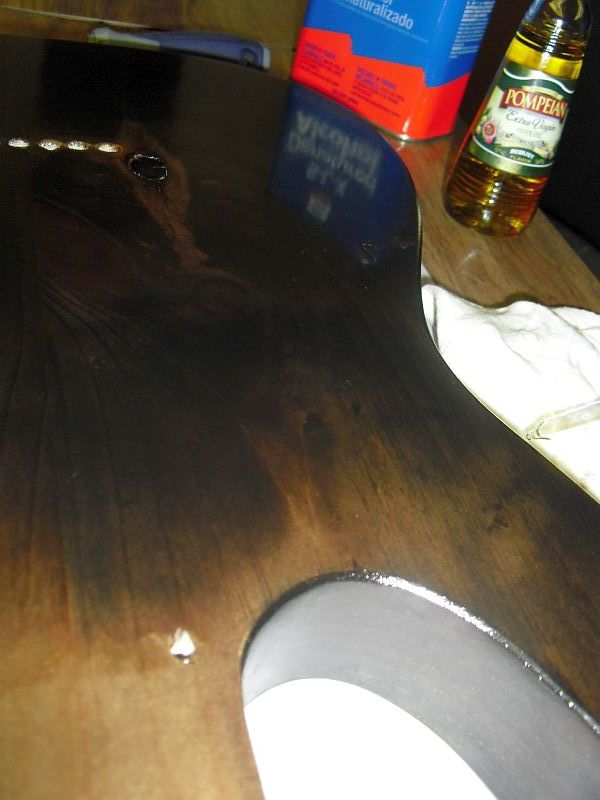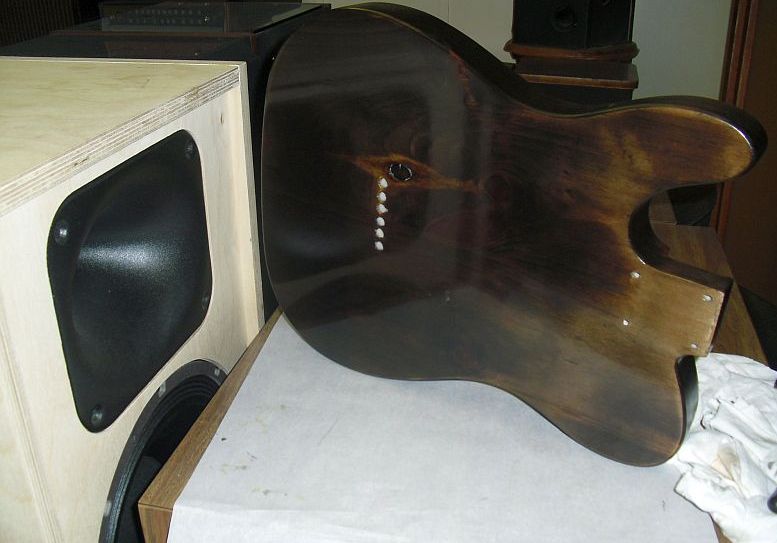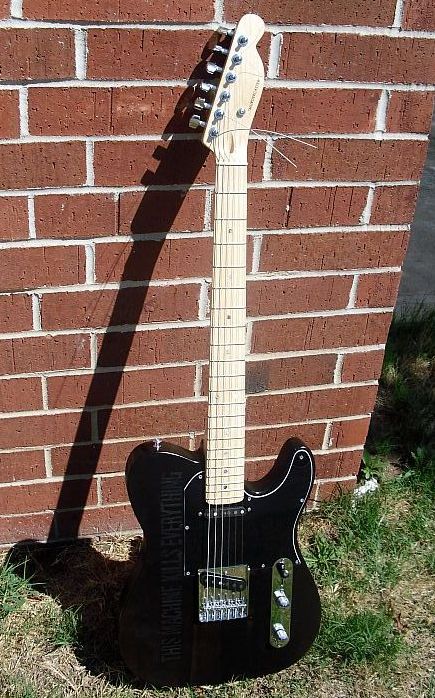sprayin' it everywhere, practically soaked myself in alcohol... yet it's gettin' hard again
I'm here to tell you about nature's miracle wood-finishing product. It's called shellac. (No, I'm not talking about the band of the same name, which also just happens to be one of my favorite bands ever.) And like so many of the best things in life, shellac comes out of a bug's ass.
If you read my first entry for the week, you may be able to surmise that I come from a long genetic line of males who are fascinated by the way things work and are predisposed to DIY sorts of endeavors, but who are also predisposed in such endeavors to pursuing the fastest / cheapest route to results rather than figuring out how to actually do it the right way.
Since I have not yet become a homeowner, I have not yet had opportunity to stupidly risk the lives of my own friends and family in the pursuit of such endeavors, as my father was obviously so fond of doing. But I did decide to get interested in guitar building a year or so ago. (Yes, in a way, this is going to be another guitar post. Sorry.)
I'm a little more realistic about my skills and personal limits than my dad. As I started "designing" my first attempt at an electric guitar build, I couldn't help but admit that all of my past woodworking endeavors had turned out quite poorly.
So I basically bought all the parts prefab, including an unfinished, pre-cut / -routed body and equally unfinished but already carved and fretted neck. If this went well, I told myself, I'd use the encouragement and move on to trying to carve up the wooden parts from scratch. (I'm still planning to do this... soon. Right.)
Playing an unfinished / raw-wood guitar is not a great idea - this is something you're going to handle constantly and sweat all over every time you use it, and unsealed wood isn't great at tolerating being coated in human moisture.
However, I already knew going in that the finishing work would probably be the most labor-intensive part of the project, and that finishing a guitar the "factory way" is especially difficult and kinda dangerous stuff. Most of the materials they use to make guitars in factories are tough to work with, highly toxic, and require all manner of specialized gear and settings to get good results and/or avoid killing yourself. On top of it all, it usually takes a month or so of fairly laborious effort / multiple coats and rework to "do it right" with these more common guitar-finishing products.
No way, hoss. For my first impatient and genetically-typical half-assed build, I sought out another method-- something fast as hell and non-toxic.
What I ended up with was shellac. Like I said at the start, it's kind of a forgotten miracle product. Shellac used to be the most commonly used furniture finish in the world, coming just after waxes and just before all the crazy poly lacquers that took over in the middle 20th century. It's still used on very fine furniture and acoustic guitars / violins / etc., particularly in a method known as French polishing.
Shellac itself is non-toxic, to the point where it's often used as a food coating, and inhaling it certainly won't kill or poison you (hey, it even smells a lot like apples). You can safely spray it indoors, long as everything around it is covered up to avoid getting sprayed too. It dries within an hour or two, and can even "work out" its own mild runs on additional coats to some extent.
Unfortunately, shellac's relative unpopularity these days means that getting your hands on some is difficult and often comparatively expensive. The best shellac comes "fresh" in dried flake form, essentially straight out the aforementioned Asian lac bug's ass, looking just a tad like little fragments of peanut brittle in a bag. You dissolve the flakes in pure alcohol, which is shellac's natural solvent. These days, the combo of flakes and alcohol might cost you anywhere from $40-70 a gallon depending on the desired "cut" i.e. strength / proportion of shellac to alcohol; shellac ain't cheap, and thanks to libation taxation, Everclear is worse.
(Every finishing material has a solvent - a volatile component that quickly evaporates and allows the finishing substance to "dry," but which also allows its removal later on. Alcohol is relatively non-toxic compared to the horrible, super-evil solvents involved in other finishes as well, which is another reason why shellac is so great. But this also means you'd be well-advised not to spill your glass of neat whiskey on your French-polished acoustic guitar or dining room table.)
If I had this to do all over again, I'd use real-deal flake shellac. But to keep my costs and wait time down, I ended up going with Zinsser premixed shellac - about the only such brand / product available, at least in the States. A little $14, 8-oz can was more than enough to complete the whole job.
Before applying the sealing coat of shellac on the raw pine body, I tried another interesting treatment I'd read about on the Internet - a mix of steel wool dissolved in vinegar, with an all-over pretreatment of super-strong black tea. This is a common technique for "antiquing" wood that brings out the natural tannins in the wood and changes its color semi-drastically. I was going for a natural, "weathered" silvery-grey...


...but as the first coats of shellac went on on top of the tea-vinegar-iron-oxide "stain," the guitar quickly went toward a dark molasses brown. I mixed in some black dye with the shellac to try and push an overall sense of gray-blackness... and the brown just got browner. Oh well, the thing wants what it wants!


On the back of the body, which was the last side of the body I finished, I decided to experiment with the aforementioned French-polishing method, a shellac-specific trick that is a lot more hands-on and time- / labor- / patience-intensive than simply spraying and wet-sanding the stuff. But it ended up being kind of relaxing work at the same time. As the hand-rubbed coats of shellac built up and melted into each other, the back of the body soon built up this nice high-gloss shine. If I had it to do over again, once again, I would have done the whole guitar like this.


I did the unfinished maple neck this way too. I was a little worried that shellac might not hold up with actual use on a guitar... but it's been a year, this guitar gets played / beaten to death in loud / angry rehearsals at least five hours a week, and the finish is still looking just as nice as when I completed the guitar.
Granted, I don't sweat much compared to a lot of players. Or maybe it's just that I don't drink nearly enough to exude shellac's natural solvent from my fingertips... although it seems like my wife sure can smell it on me when I have just half a High Life.

Give Everclear 'n' bug-ass juice a shot for your next refinishing project. The environment will thank you, and hell, you might just enjoy it.
If you read my first entry for the week, you may be able to surmise that I come from a long genetic line of males who are fascinated by the way things work and are predisposed to DIY sorts of endeavors, but who are also predisposed in such endeavors to pursuing the fastest / cheapest route to results rather than figuring out how to actually do it the right way.
Since I have not yet become a homeowner, I have not yet had opportunity to stupidly risk the lives of my own friends and family in the pursuit of such endeavors, as my father was obviously so fond of doing. But I did decide to get interested in guitar building a year or so ago. (Yes, in a way, this is going to be another guitar post. Sorry.)
I'm a little more realistic about my skills and personal limits than my dad. As I started "designing" my first attempt at an electric guitar build, I couldn't help but admit that all of my past woodworking endeavors had turned out quite poorly.
So I basically bought all the parts prefab, including an unfinished, pre-cut / -routed body and equally unfinished but already carved and fretted neck. If this went well, I told myself, I'd use the encouragement and move on to trying to carve up the wooden parts from scratch. (I'm still planning to do this... soon. Right.)
Playing an unfinished / raw-wood guitar is not a great idea - this is something you're going to handle constantly and sweat all over every time you use it, and unsealed wood isn't great at tolerating being coated in human moisture.
However, I already knew going in that the finishing work would probably be the most labor-intensive part of the project, and that finishing a guitar the "factory way" is especially difficult and kinda dangerous stuff. Most of the materials they use to make guitars in factories are tough to work with, highly toxic, and require all manner of specialized gear and settings to get good results and/or avoid killing yourself. On top of it all, it usually takes a month or so of fairly laborious effort / multiple coats and rework to "do it right" with these more common guitar-finishing products.
No way, hoss. For my first impatient and genetically-typical half-assed build, I sought out another method-- something fast as hell and non-toxic.
What I ended up with was shellac. Like I said at the start, it's kind of a forgotten miracle product. Shellac used to be the most commonly used furniture finish in the world, coming just after waxes and just before all the crazy poly lacquers that took over in the middle 20th century. It's still used on very fine furniture and acoustic guitars / violins / etc., particularly in a method known as French polishing.
Shellac itself is non-toxic, to the point where it's often used as a food coating, and inhaling it certainly won't kill or poison you (hey, it even smells a lot like apples). You can safely spray it indoors, long as everything around it is covered up to avoid getting sprayed too. It dries within an hour or two, and can even "work out" its own mild runs on additional coats to some extent.
Unfortunately, shellac's relative unpopularity these days means that getting your hands on some is difficult and often comparatively expensive. The best shellac comes "fresh" in dried flake form, essentially straight out the aforementioned Asian lac bug's ass, looking just a tad like little fragments of peanut brittle in a bag. You dissolve the flakes in pure alcohol, which is shellac's natural solvent. These days, the combo of flakes and alcohol might cost you anywhere from $40-70 a gallon depending on the desired "cut" i.e. strength / proportion of shellac to alcohol; shellac ain't cheap, and thanks to libation taxation, Everclear is worse.
(Every finishing material has a solvent - a volatile component that quickly evaporates and allows the finishing substance to "dry," but which also allows its removal later on. Alcohol is relatively non-toxic compared to the horrible, super-evil solvents involved in other finishes as well, which is another reason why shellac is so great. But this also means you'd be well-advised not to spill your glass of neat whiskey on your French-polished acoustic guitar or dining room table.)
If I had this to do all over again, I'd use real-deal flake shellac. But to keep my costs and wait time down, I ended up going with Zinsser premixed shellac - about the only such brand / product available, at least in the States. A little $14, 8-oz can was more than enough to complete the whole job.
Before applying the sealing coat of shellac on the raw pine body, I tried another interesting treatment I'd read about on the Internet - a mix of steel wool dissolved in vinegar, with an all-over pretreatment of super-strong black tea. This is a common technique for "antiquing" wood that brings out the natural tannins in the wood and changes its color semi-drastically. I was going for a natural, "weathered" silvery-grey...


...but as the first coats of shellac went on on top of the tea-vinegar-iron-oxide "stain," the guitar quickly went toward a dark molasses brown. I mixed in some black dye with the shellac to try and push an overall sense of gray-blackness... and the brown just got browner. Oh well, the thing wants what it wants!


On the back of the body, which was the last side of the body I finished, I decided to experiment with the aforementioned French-polishing method, a shellac-specific trick that is a lot more hands-on and time- / labor- / patience-intensive than simply spraying and wet-sanding the stuff. But it ended up being kind of relaxing work at the same time. As the hand-rubbed coats of shellac built up and melted into each other, the back of the body soon built up this nice high-gloss shine. If I had it to do over again, once again, I would have done the whole guitar like this.


I did the unfinished maple neck this way too. I was a little worried that shellac might not hold up with actual use on a guitar... but it's been a year, this guitar gets played / beaten to death in loud / angry rehearsals at least five hours a week, and the finish is still looking just as nice as when I completed the guitar.
Granted, I don't sweat much compared to a lot of players. Or maybe it's just that I don't drink nearly enough to exude shellac's natural solvent from my fingertips... although it seems like my wife sure can smell it on me when I have just half a High Life.

Give Everclear 'n' bug-ass juice a shot for your next refinishing project. The environment will thank you, and hell, you might just enjoy it.